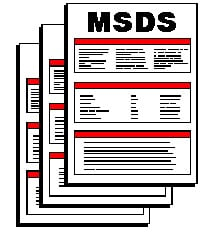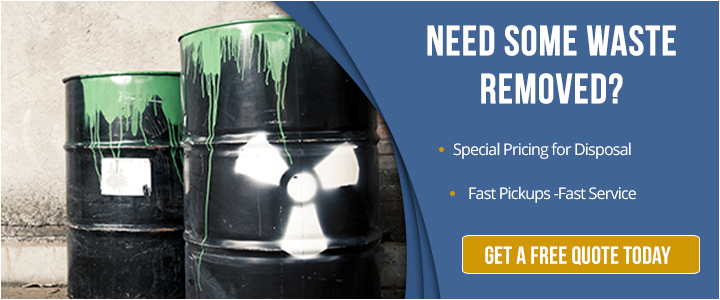MSDS stands for Material Safety Data Sheet.
Material Safety Data Sheets, also known as Safety Data Sheets (SDS) are documents that provide detailed information about hazardous substances or materials. Their intent is to inform and guide individuals, including employees, emergency responders and consumers, about the potential hazards, safe handling, storage and disposal of a specific substance.
Although the term “MSDS” is still widely used in industrial, laboratory and even university settings, these important documents are now technically referred to as Safety Data Sheets in California. OSHA (Occupational Safety and Health Administration) mandated that Safety Data Sheets officially replace Material Safety Data Sheets by 2015, though both terms are used interchangeably in many settings today when referring to the SDS forms.
16 Sections Of A Safety Data Sheet
Today’s Safety Data Sheets have 16 standardized sections that make it easier for individuals to locate important information concerning the substance or material that is being used. The Hazard Communication Standard (HCS) requires that these SDSs be in a uniform format and include the section numbers, headings and associated information below under each heading:
Section 1: Identification
- Product identifier
- Manufacturer or distributor/supplier name, address and phone number
- Emergency phone number
- Recommended use
- Restrictions on use
Section 2: Hazard(s) Identification
- All hazards regarding the chemical product
- Required label elements
Section 3: Composition/Information on Ingredients
- Information on chemical ingredients
- Trade secret claims
Section 4: First-aid Measures
- Important symptoms/effects, acute, delayed
- Required treatment
Section 5: Fire-fighting Measures
- Suitable extinguishing techniques and equipment
- Chemical hazards from fire
Section 6: Accidental Release Measures
- Emergency procedures
- Protective equipment
- Proper methods of containment and cleanup
Section 7: Handling and Storage
- Protective measures for safe handling and storage, including incompatibilities
Section 8: Exposure Controls/Personal Protection
- OSHA’s Permissible Exposure Limits (PELs)
- ACGIH Threshold Limit Values (TLVs)
- Any other exposure limit used or recommended by the chemical manufacturer, importer or employer preparing the SDS where available as well as appropriate engineering controls
- Personal protective equipment (PPE)
Section 9: Physical and Chemical Properties
- Chemical’s characteristics
Section 10: Stability and Reactivity
- Chemical stability and possibility of hazardous reactions
Section 11: Toxicological Information
- Routes of exposure
- Related symptoms, acute and chronic effects
- Numerical measures of toxicity
Section 12: Ecological information
- Potential toxicity to aquatic organisms, plants and animals
- Potential for degradation over time
- Substance’s tendency to accumulate in organisms, particularly in food chains
- Mobility in soil
- Results of PBT(Persistent, Bioaccumulative and toxic) and vPvB (very Persistent and very Bioaccumulative) assessments
Section 13: Disposal Considerations
- Disposal instructions
- Waste classification
- Special precautions
- Packaging and labeling requirements
- Local regulations
- Transport consideration
- Emergency procedures
Section 14: Transport Information
- Hazard class and divisions
- Packing group
- Environmental hazards
- Transport precautions
Section 15: Regulatory Information
- Specific health, safety and environmental regulations about the substance
- Permits and authorizations
- Specific codes or guidelines related to the substance
- Other regulatory information relevant to the substance
Section 16: Other information
- The date of preparation or last revision
Although OSHA regulates and enforces the use of SDSs, the agency does not enforce sections 12 through 15. Those are regulated by other agencies like the U.S. Department of Transportation.
Employer Responsibilities With Safety Data Sheets
Employers must ensure that employees can easily access Safety Data Sheets for any hazardous chemical in the workplace, according to OSHA.
This mandate can be handled in a number of ways, including keeping the SDSs in one place in a readily accessible binder. SDSs can also be kept digitally as long as employees have immediate access to the information if needed without having to leave their work areas. However, a backup should be available as well in case there is a power outage or another type of emergency that might limit quick access to digital files.
OSHA also recommends that employers designate a person responsible for obtaining and ensuring all SDSs are up-to-date. If an employer does not have an SDS for a hazardous substance in the facility, it’s important to contact the manufacturer of the substance to obtain one.
Another responsibility of employers involves when SDSs are updated. When a manufacturer changes its product formulation or new information is released about substance hazards, the SDS must be revised. The manufacturer must then make the revised SDS available with every new shipment.
Employers have 30 days of receiving a new or revised SDS to train any impacted employee on new information within the product Safety Data Sheet.
Establishing A Culture Of Safety
Establishing a culture of safety in the workplace helps to ensure the well-being and protection of employees. By prioritizing safety, employers can create an environment where workers can perform at a high level without unnecessary risks or hazards. This emphasis on safety not only prevents accidents but also boosts employee morale and retention.
In addition to making sure you have all the correct and updated SDSs on-hand and they are readily accessible to employees, you can take a proactive approach to safety by partnering with a hazardous waste expert that offers a walk-through program.
A hazardous waste walk-through is consultative in nature and helps ensure your company is meeting the regulatory complexities of the Resource and Recovery Act (RCRA), the Hazard Communication Standard, and other local, state and federal laws.
During a walk-through, a waste expert will conduct an evaluation of your hazardous waste procedures. It’s important to always partner with an experienced and properly licensed hazardous waste company for the walk-through to ensure you are meeting the most up-to-date regulations.
The goal of a walk-through is to catch potential issues BEFORE they become a problem. Walk-throughs can address a number of areas in your waste management and how you store chemicals, substances and other potentially hazardous items on-site, including waste manifesting, labeling procedures, emergency readiness and employee training.
An effective safety culture extends beyond legal compliance and includes proactive measures to identify and mitigate potential risks. A hazardous waste walk-through program can help you accomplish this while fostering a culture where employees feel empowered to identify safety issues. In the end, your image as an organization will benefit while you create an environment where employees feel valued.


Comment